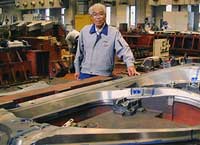|
|
|||||||
|
|
|||||||
|
|||||||
| | Web Japan >> | Trends in Japan >> | Business & Economy >> | Molding the Future | |
|
MOLDING THE FUTURE Japanese Molds Play Key Role in Industry (November 28, 2003) Metal molds are indispensable in the manufacture of industrial products; the more complex the product, the more advanced the molds needed to produce it. Japanese molds have a global reputation for precision and durability. Most mold manufacturers are small companies whose employees are constantly striving to design and create new molds and refine and hone their skills. These companies have thrived by consistently thinking up new designs and producing top-quality molds in response to requests from large corporations. With product cycles becoming shorter and shorter, mold-making technology is advancing at a remarkable pace. The craftsmen who create metal molds are well aware that they have to meet the needs of the ever-evolving consumer market in order to succeed.
Skilled Workers Make Invaluable Contribution Approximately 80% of the roughly 12,000 makers of metal molds in Japan are small enterprises, many of which are concentrated in the Kamata district of Tokyo, Higashi-Osaka, and the northern part of Kyushu. In many ways, these hives of mold-making activity are the foundations on which the rest of Japanese industry stands. The skilled artisans of these factories, which employ anywhere from a few people to a few dozen, design and create high-quality metal molds to meet the exacting specifications demanded by large manufacturers. These days cutting-edge information technology plays a key role in the creation of metal molds. Plans are drawn up using computer-assisted design, and the molds are fashioned using high-level machine tools. But the task of making a perfect metal mold cannot be left entirely to machines. When computers reach their limits, the skills and experience of the artisans play a critical role. For example, when a steel plate is pressed into a freshly made metal mold, it may come out bent or cracked. When this happens, an artisan wearing cotton gloves will gently stroke the inside of the mold, smoothing out imperfections that may be as tiny as a hundredth of a millimeter in height. This is a task that can only be performed by a highly skilled craftsman. It is this combination of high technology and human dexterity that explains why Japanese metal molds are considered the best in the world. Large, ultraprecise metal molds are the sole province of Japan. The big three automakers in the United States all rely on Japanese molds to produce the bodies of their vehicles, and Germany's Mercedes-Benz has also begun using Japanese molds. For these reasons, Japan is effectively the world center for metal-mold production. Some ¥1.64 trillion ($14.9 billion at ¥110 to the dollar) worth of metal molds were produced in Japan in fiscal 2000 (April 2000-March 2001), roughly twice as much as in the United States, four times as much as in Germany, and by far the most of any industrialized nation.
Second Thoughts about Shifting Production to China While the quality of Chinese molds used to be far from the level of the top-quality ones produced in Japan for use in the manufacture of things like precision parts, China is gradually becoming more competitive in terms of quality. In addition, the cost of metal molds in China is only about half what it is in Japan. Even so, there is enduring demand for Japanese molds. This summer a maker of metal molds for plastics based in Kyushu's Fukuoka Prefecture received an order from a company that produces containers for food flavorings in China. These types of orders from companies that have shifted production overseas, claims the president of the Fukuoka metal-mold maker, are not unusual. "High quality can be equally important as low cost." To be sure, the manufacturing industry is undergoing structural changes as assembly plants continue to move overseas. But with no letup in the demand both in Japan and elsewhere for high-quality products, Japan is likely to retain its position as a base for developing new manufactured goods for the foreseeable future, and this will enable the metal-mold industry to continue going from strength to strength. Copyright (c) 2004 Web Japan. Edited by Japan Echo Inc. based on domestic Japanese news sources. Articles presented here are offered for reference purposes and do not necessarily represent the policy or views of the Japanese Government. |
ROBOT SUITS (August 28, 2003) TURNING POINT (August 7, 2003) SMALL BUT MIGHTY FACTORIES (January 17, 2001) |
|
|



